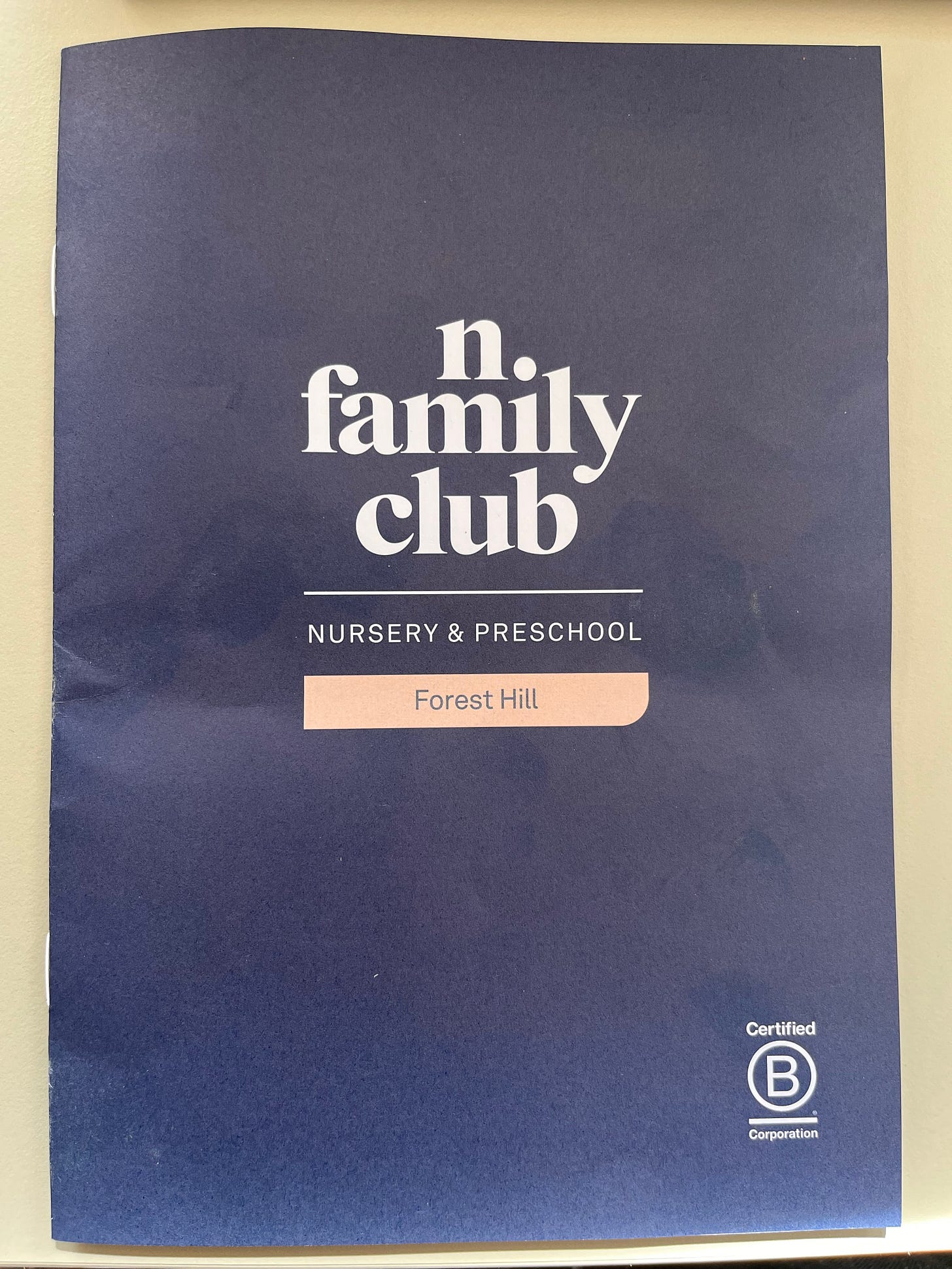Atelier WeekNotes w/c 8 April
0/DETECTING: B-Corp Movement: a signal of quality; SBTi: who guards the guards? In the Atelier: 'Influential Trajectories' powering SoSS. ReadingNotes: Transformative Outcomes.
I am writing newsletter of #weeknotes of starting the Atelier of What’s Next (a studio for initiatives at the frontier of generating a better future). For my rationale for starting the Atelier see here.
A normal work-week has lead to a long but exciting WeekNotes. One small thing: there is now an Atelier of What's Next website (so, I've hit my Feb target 2 months late). Right now it is just a holding page, point people to this SubStack. I will develop it more int he second half of the year.
This week covers:
0/DETECTING
B-Corp Movement: a signal of quality
SBTi: who guards the guards?
In the Atelier
'Influential Trajectories' powering SoSS.
ReadingNotes
Transformative Outcomes: assessing and reorienting experimentation with transformative innovation policy
How can the Atelier of What's Next be of service to you, and your purposes? We'd love to hear from you. Perhaps you have a challenge or idea to put in the studio. Maybe one of our existing topics appeals to you. What if you love to make new things happen by being part of the studio? Or if you have feedback or comments that would improve this deck. Either click the button below or email davidbent@atelierwhatsnext.org.
0/DETECTING
B-Corp Movement: a signal of quality.
A leaflet dropped through my door for n family club, a chain of nurseries through London and the South East. What struck me was how prominent their B Corp Certification was on that flyer:
A bit of internet digging shows some 30+ nurseries, in places with a strong aspiring middle class (wanting quality nursery sa both parents are working, but can't necessarily afford a live-in nanny or au pair). They have their impact page here
It is a sign of success of the B Corp movement that the certification is used so prominently. I mean, how many people are going to know the ins and outs of the certification process. So, mostly it is a signal: you can trust us with your child because we take impact seriously. I read it as a symbol of quality.
Amazingly (to me) the nursery chain impact page states: "As the climate crisis intensifies and societal inequality grows, the need to bring about systemic change is clear."
So, nursery chains are more radical than the leader of Labour Party.
Amazing to hear the phrase 'systemic change' used in the website of a nursery chain. A nursery chain. Not a campaigning NGO, or even a leading corporate. But a medium-sized business, where sustainability isn't a core quality of the service (I doubt the first questions a parent would ask would be about climate change).
All this speaks to the much wider understanding of the sustainability issues, that these are not just environmental, and there is a desire for action.
There is a really good episode on the B Corp Movement by 'All In' (co-hosted by David Grayson, a friend of mine). They interview Bart Houlahan, who co-founded the movement after he sold his previous business, and watched the new owners junk all of the for-purpose features (before then going bust).
WHAT NEXT. Consider making the Atelier of What’s Next a B Corp (actually, I may not have a choice).
SBTi: who guards the guards?
My WhatsApp message boards have been melting with people discussing the argument happening in the Science-Based Targets Initiative (SBTi).
In its own words, SBTi is "a corporate climate action organization that enables companies and financial institutions worldwide to play their part in combating the climate crisis".
In effect, it is private regulator, by providing standards, tools and guidance to companies and financial institutions on climate targets and actions are compatible with the Paris Agreement. For instance, "in 2021 the SBTi launched the world's first Corporate Net-Zero Standard, to ensure that companies’ net-zero targets are consistent with what is required to achieve net-zero no later than 2050".
The SBTi had a strong stance on how corporations use offsets, making it harder to pollute over here and then buy a promise from someone else that they won't pollute over there. SBTi also had a strong technical governance, with various bodies of independent experts who set the details of the standards.
On Tue 9 April, the SBTi board issued a statement on use of environmental attribute certificates, making it easier to use credits. This surprised the staff and the independent experts, who thought they were still working on the consultation.
The Guardian carried a story of the staff in revolt. FT Moral Money newsletter implied that SBTI was responding to pressure from one of its key funders, the Bezos Earth Fund (set up by Jeff Bezos with money he made in the name of the Amazon, insert irony here). A Bloomberg colour piece had the same narrative. I've seen a letter, signed by many of the technical advisors, strongly disagreeing with both the substance and manner of the decision.
On Friday 12 April, the original board statement was expanded with a clarification statement, saying: "No change has been made to SBTi current standards".
So, a storm in a teacup, and now all over. Well, no.
The trust in SBTi is damaged. Regardless of the substance of the decision, you cannot be a regulator with a procedure for changing your standards, and then go outside that procedure. Why should anyone trust your regulations in the future? This is the old problem of 'who guards the guards themselves?'
A senior sacrifice? The most obvious way to rebuild trust is to do some painful change in public: apologise for mistakes; show how they can't happen again; and have a senior person resign (and maybe some board members too).
Trust in climate action. Hopefully we will look back on this as a footnote. But still, to mobilise large amounts of money, the investors need to have confidence in the domain they are investing into. Everything that undermines that confidence slows things down.
The limits of private regulation. All regulation can be co-opted by those it regulates. That happens in the public version too (a key reason behind the Great Financial Crisis in the late 2000s). Private regulation is also vulnerable, especially where it is dependent on a small number of donors, and also where those donors also want to make money from the market being regulated (as the Bloomberg story says of the Bezos Earth Fund).
Billionaire funders: the friends of a socially-just, environmentally-secure future? The Bezos Earth Fund told Bloomberg that “we do not make decisions for [SBTi], we do not sit on their board, and we weren’t involved” in the April 9 announcement.
Still, it is possible for them to exert influence, and maybe also pressure. Every charity or business I've known pays attention to the interests and concerns of big donors/customers. If the Bezos Earth Fund organised a workshop which clearly sided with more offsets, that would be a signal for the senior managers to take seriously, without the Fund itself making decisions or sitting on the SBTi board.
As I wrote the other week, on the Adani Green Energy sponsorship of the Science Museum Energy Revolutions Gallery, after decades of neoliberalism hollowing out government and civil society, who has the discretionary funds for novelty?
Cory Docotorow has written that not only is every billionaire a policy failure, but also every billionaire is a factory for producing policy failures.
I remain torn: deep scepticism about the motives of the billionaires; and also a deep pragmatism that about the need to act with today's realities
Conflict can be necessary. One of the WhatsApp groups I am on has lots of people saying that we need to keep the community together, and avoid fragmentation.
Hmm. I'm not for having conflict just for conflict's sake. And, yes, those who are against on action on climate will use any uncertainties and conflicts to push more predatory delay.
But, if there are material differences on the manner and substance of a decisions, these should not be buried. If there is no backlash against abusing power, then why not do so again?
WHAT NEXT.
Keep following the news!
Given that the Atelier will, at some point, apply for funding, start to work through how to maintain authenticity and credibility. (It is OK to listen to what funders want; it's not OK to change something vital to the Atelier's identity or values just to satisfy a funder.)
In the Atelier
'Influential Trajectories' powering SoSS
Step: 4/DEVELOPING. Theme: Method; Sectoral Transformation; Governance; Futures.
A key focus of last week was developing the method that is powering the State of Sustainable Shipping. There were some breakthroughs, including a better name 'influential Trajectories'
Background
The method had come up in the WeekNotes previously as 'Imagining transformative pathways for decision-making'.
Early June 2023: Scanning for the State of Sustainable Shipping (SoSS) covers how SoSS came out of a strategy process with the Sustainable Shipping Initiative (‘SSI’), the core purpose (tracking and challenging the sector on the roadmap to a sustainable shipping industry).
Late June 2023: Exploring a possible partnership with the School of Design at the Royal College of the Arts.
July 2023: Drafting the Open Protocol, with the specifications for each step.
Early January 2024: Announcement of the pilot funding.
Late January 2024: The Abstract for the Anticipation 2024 conference. (I've just learnt that was successful.)
February 2024: Small update on using Cyenfin's Sense-Maker.
The purpose of the SoSS: to accelerate change on specific sustainability issues within the maritime sector, by tracking and challenging the industry’s progress in ways that stimulate action.
Concept. Use the horizon-scanning and sense-making techniques being developed for SoSS in other similar situations.
As well as the SoSS project itself, I also have an opportunity to pilot the method with various organisations in Aotearoa New Zealand in August. The Explainer Text below is taken from collateral sent to people as an invitation.
Assembling the building blocks.
Last week I was able to spend some quality time on the method that powers SoSS.
Wrote up my ReadingNotes on 'Transformative Outcomes', which comes out of the Transformational Innovation Policy Consortium. Excellent -- see below for a summary.
Made extensive ReadingNotes on:
'Roadmapping for Strategy and Innovation: Aligning technology and markets in a dynamic world' by Dr Robert Phaal and others. Excellent. Notes out soon.
'On order and complexity in innovations systems: Conceptual frameworks for policy mixes in sustainability transitions' by Grubb et al (the 'al' includes my UCL Module lead, Dr Will McDowall). Also excellent. Notes out soon.
So, I have much better sense of the different elements I want to assemble, all of which has gone into the Explainer Text below.
What's in a name?
Quite a lot. Calling the method SoSS conflates the specific use (shipping) with the method. I had been calling it 'transformative pathways', but that method already exists here, from the STEPS Centre.
I wanted a name that would convey something about what it is for. I also want to avoid creating something which just uses the idea of the future to reinforce current patterns (more on that criticism of corporate futures here).
I found myself returning to my ReadingNotes of 'Transforming the Future: Anticipation in the 21st Century', edited by Riel Miller.
My view is that people want certainty, and want a method which will tell them what will happen (futures as prediction). But I believe there are many possible futures emerging now. So, the most appropriate use of 'time-after-now' is more as a disposable construct.
What if we use the future as a prompt which, because it provides a kind of anchor to our imaginations, helps us make-sense of now and invent novelty? Also, what if we realise that success for a method like this is not about accurately predicting the future, but helping us to shape the future we would prefer?
Hence, 'Imagining Influential Trajectories', or 'Influential Trajectories' for short. I'm guessing the name will stick for at least 6 months (until after the pilotting). Then I can look again.
Explainer text
Would you like to imagine trajectories from today to a better future for your organisation, region, sector or issue? And do that in a way which deepens people’s understanding and connections? All with the aim of accelerating action now?
Influential Trajectories is an approach to understanding what is happening now, identifying what will make a difference and creating shared understanding across stakeholders
Influential Trajectories comes out of my work with companies, non-profit organisations and public bodies plus latest academic research on anticipatory governance. In my experience, decision-makers are often looking for insight which helps them understand what is going on, and gives them greater certainty on how they can deliver on their goals.
Famously, ‘making predictions is difficult, especially about the future’. As the name implies, the Influential Trajectories approach is not predicting the future, but influencing it. The core assumption is that tomorrow is emerging from today. If people can have a greater understanding of what is happening, they can act to shape the future towards their preferences.
The four key steps of Influential Trajectories deepen people’s shared understanding of where they want to go, what is happening now, and what they can do now, together or alone.
Imagining useful future milestones. Many organisations will already have a vision they are already aiming for, in which case this step Is not needed.
Crafting candidate trajectories. Drawing on technology road-mapping and latest system transitions theory, we imagine several different ways to reach the future milestones. Each of these trajectories describes what would need to be true in different dimensions, like political, social, technological, and economic.
Testing possibilities with current evidence. Now we can check the status of the different trajectories (stalling, improving, accelerating) and what would make a difference.
Acting for a better future. Knowing the current dynamics of the trajectories allows the organisation to identify the initiatives and investments would make a difference now.
Another of the founding assumptions is that more of the same will not lead to a sustainable future. Therefore, Influential Trajectories needs to avoid the same habits of thinking that have created the status quo. So, there are two design principles (drawn from a global, multi-disciplinary academic collaboration called the STEPS Centre):
‘Opening Up’ to different kinds of inputs and unusual methods of analysis.
‘Broadening Out’ recommendations and outputs to be more plural and conditional, reflecting assumptions, circumstances or perspectives embedded in conclusions.
As such, Influential Trajectories is already open to indigenous perspectives and other ways of knowing that are outside the mainstream orthodoxy. Putting the ‘Opening Up’ and ‘Broadening Out’ into practice should help us avoid merely defaulting to legacy thinking (which often leads to resource extraction and the inequitable sharing of rewards).
The method can be applied, in whole or in part, for different uses (which can overlap):
System diagnosis (where a ‘system’ could be a sector, a region or a challenge).
Investment decision-making.
Crafting an organisational strategy.
Creating a shared understanding of a situation across a diverse group.
WHAT NEXT
Sprint mode on the crafting the method.
Inviting more people to pilot the method (not just in Aotearoa New Zealand). If that could be you, do get in touch.
ReadingNotes
Transformative Outcomes: assessing and reorienting experimentation with transformative innovation policy
Transformative Outcomes is a process-oriented heuristic that comes from the Transformative Innovation Policy Consortium (TIPC). It comes from using the Multi-Level Perspective (MLP), which describes transitions in terms of: landscape pressure on an otherwise dynamically stable regime; the regime struggles; opportunities for mature niches of innovations to become the new mainstream. (Link to original paper.)
The 12 Transformative Outcomes (TOs) have come from using the MLP with policy-makers, as they try to drive transformation. ‘Outcome’ is being used very widely here. I understand them as on-going functions that area usually needed for transformative change.
The TOs are organised in three sets of four:
Building and nurturing niches, so there are innovations that can be adopted by the mainstream.
Expanding and mainstreaming niches, so that innovations move into the regime.
Opening up and unlocking regimes, so that the existing mainstream gets out of the way
The idea is to use them as a starting point for what might be missing. They are not supposed to be in a particular order or importance (though there is a claim to completeness).
My instinct is that they will be useful as a diagnostic tool: describe what is currently happening, and identify gaps where interventions are likely to be needed.
As with MLP in general, it is strong on technical and technocratic, as in the innovations are presumed to be physical widgets (rather than, say, methods or beliefs), and the users are assumed to be well-intentioned, evidence-led policy-makers.
Hence the blindspot: cultural and political influences on the transformation. The paper explicitly says that “how TOs are enacted is a deeply political process, riddled with choices and conflicts between multiple actors with incongruent interests”. But I didn’t get much guidance from the paper on what to do with that insight, or what might be needed outside of the TOs to deal with the deeply embedded political process.
Similarly, the role of culture — imaginaries, stories, lifestyle expectations, values, movements — is only hinted at as being part of the Landscape, which is assumed to be beyond the influence of single actors. Tell that to Nigel Farage on Brexit or XR on UK’s commitment to Net Zero.
Even with those caveats, this looks likfe a very useful development to the MLP framework.
More here.







